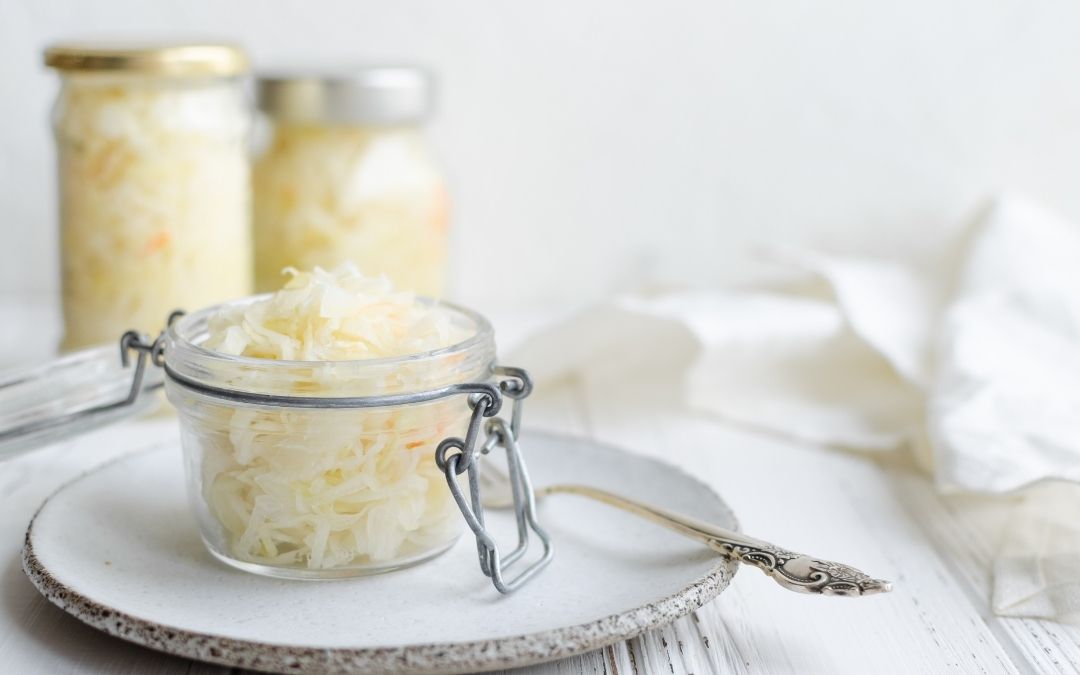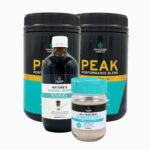Sometimes I feel like I’m fighting an unwinnable battle regarding the health and safety of our foods. Irradiation of fruits and vegetables in Australia is now on the agenda and more and more genetically modified microbes are being created to manufacture plant-based meats, food additives, flavours and sweeteners. It’s a minefield that has no long-term studies – except for one big giant experiment on the human race’s health and I personally am not prepared to be a part of it.
With knowledge comes power for the individual and their families. I’m more determined to grow my own food or get to know my local farmer the more I learn about the chemical, agricultural and food manufacturers and the vested interests in food standards. I’d rather rely on my regenerative farmer more than anyone else when it comes to my health, including doctors. These farmers are the people who will honestly create healthy foods for humans and in turn change the trajectory of human and planetary health.
Fermentation is used to make many food stuffs, but most fermentation processes use genetically modified micro-organisms (you can read all about it in my article here).
Instead, let’s talk about natural food fermentation, a far more enjoyable, healthy and historical way to ferment.
Fermentation using non-GM microbes is a natural process that converts the carbohydrates (sugars and starches) in our food into acids and alcohols. These byproducts give fermented foods and drinks their tartness and zestful flavours. As well as an increase in health-giving metabolites, fermentation also increases the beneficial bacteria of food and drink. The food these bacteria grow on is the medium and the byproducts they produce can vary from not only acids and alcohols but vitamins, other nutrients, amino acids, fatty acids and many more substances that increase food value after fermentation.
Fermentation with specific cultures has always been about the shelf life and taste of the food. For example, fermenting dairy foods to make cheeses, cultured butters and yogurts meant that foods would last much longer and taste different to the milk from the animal. The fermentation of plant-based foods means that a harvest of cabbages would not go to waste. Instead, if we rubbed cabbage with salt and put it into containers, the resulting sauerkraut could be eaten all year round without any spoiling. The added bonus was that vitamin C, Bs and K content increased, along with other nutrients.
As we have learnt more about the microbes that live in our world and our body, the fermentation process (that is, making probiotics (microbes) along with the prebiotics (food)) is now used to improve digestion, immunity, heart and gut health.
As a result of diets like the Healthy Keto Way (HKW), GAPS and Kultured Wellness diet where carbohydrates are restricted, there is now a surge in fermented foods. If you take a blueberry, mango, banana or tomato and ferment it, the sugar content reduces dramatically and they can be included to help increase the nutrients required to run the biochemistry of the body. It also creates variety in the diet while keeping the profile of the diet as it should be.
I remember that when my daughter was on the Kultured Wellness program, one of her loves were the fermented fruits and fermented cold-pressed juices I made her. At first she was on mayo, slow-cooked meats, broths and pate, but as she progressed she was able to have resistant starches (cooked, cooled rice and potatoes) and all the fermented carbohydrates. This reduced the natural sugars and created a plethora of nutrients so that she could stay in a ketogenic state as well as feed beneficial bacteria in her gut as opposed to pathological, thus creating a healthy balance in the microbiome.
As a 21-year-old, my aunt in New Zealand gave me an old Lebanese yogurt culture. I was diligent in making sure I kept it alive. It made the most amazing yogurt which I consumed every day. After many years of enjoying this yogurt, one day the glass in the thermos where I kept it broke and I lost my beautiful traditional yogurt. By the time that happened, customs would not allow me to bring another batch of the yoghurt culture back to Australia and so it was lost to me forever. I never ever found another culture like it. Making the yogurt was time consuming; heating the milk to 90C and then cooling it to 35C, adding the culture, putting it in the thermos, saving some culture, eating the rest. If the temperature went below 35C I would have to reheat and start again.
When I met Kirsty Wirth from Kultured Wellness and she showed me how easy it was to ferment foods and drinks without heating I was hooked. On any day you can come to my house and you will see the fermenting shelf stacked with foods fermenting in her coconut kefir, coconut yogurt, apple kefir and orange kefir. And for someone who must restrict their carbohydrates, it’s a real pleasure to be able to consume blueberries, mango, bananas, tomatoes, and cold-pressed juices (these fermented juices we call Rocket Fuel aka KW).
If you are doing my Healthy Keto Way and you have been on the program diligently for 4 weeks then can I suggest you trial for yourself some healthy fermented fruits. Fermenting your tomato pastes and tomato means you can start to look at making spaghetti Bolognese with delicious spiraled zucchini.
Click here to order these beautiful ferments. I suggest you start with the coconut yogurt and kefir and then explore further. Kirsty also has videos on how to ferment. They are simple and once you start, you can’t stop. Plus, Kultured Wellness also have recipe books to help you use the ferments in delicious foods.
Through trial and error and for the health of her two children, Kirsty has chosen bacteria to enhance the health and wellbeing of the gut microbiome. You can find out more on her website. The cultures she uses include lactobacillus gassers, lactobacillus planetarium, lactobacillus rhamnosus, lactobacillus salivarius, bifidobacterium bifidum, bifidobacterium infantis, bifidobacterium lactis, bifidobacterium longum and saccharomyces boulardii. When you ferment other foods and liquids, other beneficial microbes are present that also contribute to the wonderful probiotic load. The food contributes to the prebiotic load.
Kirsty has a PhD and knows how to research her cultures. She has given me the following data to show you how each fruit/food fermented correctly and for the correct amount of time means that you reduce the sugar content of the food considerably, thereby being able to add them to the HKW. This not only gives more variety, but taste, nutrition and a way to stick to a program that is working for you.
For instance, coconut water unfermented has a sugar load of around 50% but once fermented properly using the cultures, it reduces to not greater than 1%. Apple juice goes from a sugar/carbohydrate content of around 90% to 8.5%, and coconut cream, which is lower in sugar at 7% carbs, goes to not greater than 1%. This is a dramatic difference. Once you’ve made these cultures you can then add fruits to the culture, fermenting them for between 12 and 24 hours and their sugar content will also decrease dramatically. In fact, the higher the sugar content, the greater the fizz in the ferment, which means more microbes. We do recommend, however, that if you are doing the HKW, you stick to the coconut water and cream as it has a much lower sugar content than the apple juice.
All carbohydrate-containing foods can be fermented to bring down the sugar/carbohydrate content and increase the nutrient and probiotic content. You’ll need a fermenting shelf in your kitchen (throw the microwave out and use that shelf) and a system, but it will satisfy your nutritional needs and taste buds.
Because I have a farm filled with fruit trees and I don’t want them to go to waste, I’ll often pick and ferment my fruits, drain them and then freeze them for sorbets and desserts. Fermented papaya frozen and then pureed along with one tablespoon of Changing Habits Cacao Powder makes the most incredible chocolate ice cream. Sometimes I go out to my garden and clip stevia (the herb), basil and mint and put that into the mix as well. It’s just down to your imagination and we also give you plenty of inspiration with the recipes we have on the HKW.
We are always tempted by the foods filled with sugar (carbohydrates)…it is the human Achilles’ heel. Eating these foods and having a love for them meant survival and increased fertility. The problem now is that they are available in a store, 24 hours a day, 7 days a week, 365 days of the year and advertising and marketing and the dietary guidelines have created a disaster. We are fighting a survival mechanism. The idea is to enjoy the foods in moderation so that you don’t feel like you are missing out.
If you have diabetes or pre-diabetes, your tolerance to sugar is low, but as you continue a healthy diet your tolerance will increase and the need to always ferment your fruit will decrease. Think about how long it’s taken you to get to this point, so be patient on the HKW and enjoy the knowledge you now have to consume more beautiful fruits.
Everyone is different, so start slow. Too many ferments can cause a rush of bacteria in the gut which in turn may cause bloating, flatulence and discomfort. If you do have gut issues then be sure to use tamed ferments such as Kultured Wellness. Wild ferments include kombucha. These contain many microbes that you may not know about and which may cause issues.
Trial and test. If you buy commercial ferments be sure to check the ingredients. I’ve seen many kombuchas with flavours, colours, citric acid and other dubious ingredients.
Every culture has a history of fermented foods such as kefir, sauerkraut, tempeh, natto, cheeses, kombucha, kimchi, cured meats, yogurt, lassi, traditional sourdough breads, beer, wine, olives, pickles, apple cider vinegar, umeboshi plums, cultured butter, crème fraiche and sour cream. Remember, if you buy these commercially, it is very important to read their ingredients to make sure they are truly fermented and not just filled with flavours and preservatives. Read my book Lab to Table to understand them fully.
Happy fermenting!
Cyndi









0 Comments